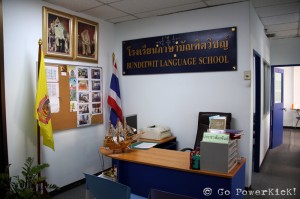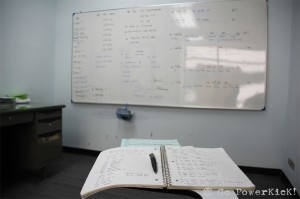Anyone who’s ever traveled to a foreign land knows the feeling of what it’s like to speak and have nobody understand. The ability to speak a foreign language, and communicate, can significantly change an experience in a country as well as open up many new doors.
For as much as I’ve had the desire to learn to speak Thai, my first three years in Thailand have been well occupied with teaching, an MBA program, writing a thesis paper and traveling when possible; which made finding the necessary time to dedicate to formal in-class lessons overwhelmingly difficult.
My time-crunch, however, didn’t stop me from picking up as much Thai as I could; when and where I could. Learning from  my students, MBA classmates, encounters in Bangkok as well as through travel; I was able to build a vocabulary that made me sufficiently dangerous when bargaining in a market, ordering food at a restaurant as well as getting and giving directions.
my students, MBA classmates, encounters in Bangkok as well as through travel; I was able to build a vocabulary that made me sufficiently dangerous when bargaining in a market, ordering food at a restaurant as well as getting and giving directions.
I was able to get by, but I was also unable to communicate past the initial point of interaction and have a full-on conversation. Knowing that whoever I was talking to was sharing valuable information which I couldn’t understand, it left me wishing I had the ability to communicate more and take advantage of what they had to say.
With a full month of free time finally opening up, I decided to put travel on hold and enroll in a Thai language class. The school I chose, Bunditwit Language School, is well-known for working with missionaries who arrive in Thailand to do work in the outer provinces. The  school offers an immersion style of learning that’s aimed at getting students fluent in reading, writing and speaking after 6 modules (6 months).
school offers an immersion style of learning that’s aimed at getting students fluent in reading, writing and speaking after 6 modules (6 months).
Each module, costing 7,000 Baht ($218), consists of 20 classroom lessons which run 4 hours per day. Students are given a handbook for each module, which costs 200 Baht ($6.22), and includes most of the material covered in class. From the first day of module 1 class was full immersion, and all in Thai. While the teachers do speak English, their style is geared toward helping build associations and answering questions in Thai rather than in English.
Coming from the English language, with a Roman alphabet and 1 tone, the plunge into the 5 tones of the Thai language and it’s script-based alphabet was quite a shock to the system. Thankfully, while model 1 is immersion into the 5 tones it does use the Romanization of words, saving the actual script writing for modules 2 through 6.
Each day in class, the Khru (teacher), teaches new vocabulary words, verbs, question words and sentence patterns. At times it can be like drinking water from a fire hose, but by the time class is over we’ve built on the previous days foundation and are well equipped to strike up conversations.
While only 1 month, this class added grammatical structure to the fragments I’d developed in my Thai language arsenal. I know I may never get the tones exactly perfect, but I definitely have more confidence to push my comfort zone and strike up conversations with that person sitting next to me on the BTS, the stranger in line at the coffee shop and to better get to know my favorite neighborhood street vendors.
I know the internet is filled with Rosetta Stone’s, ‘proven styles’, tricks and other secrets for learning new languages. However, after completing the first module here  I’d highly recommend immersion style learning. This style, if followed up by trying to have at least 1 new conversation per day to reinforce the language, will put you well on your way to getting conversational. If you’re looking to learn Thai and are in Bangkok for a slightly more extended period of time, I highly recommend checking out Bunditwit Language School… they’ll have you talkin’ Thai real well!
I’d highly recommend immersion style learning. This style, if followed up by trying to have at least 1 new conversation per day to reinforce the language, will put you well on your way to getting conversational. If you’re looking to learn Thai and are in Bangkok for a slightly more extended period of time, I highly recommend checking out Bunditwit Language School… they’ll have you talkin’ Thai real well!
Comments
More Good Reads!

Helicopter Over Oahu
May 10, 2014
May 2014 PowerKicK Of The Month
May 01, 2014
Bike The Golden Gate Bridge
April 29, 2014
Hua Hin Hills Vineyard
April 19, 2014
Songkran in Nan
April 10, 2014
April 2014 PowerKicK Of The Month
April 01, 2014
Mae Hong Son Motorcycle Loop: Mae Sot to Mae Hong Son
March 28, 2014
Becoming A Buddhist Monk In Thailand
March 20, 2014
How To Spend A Day In Ayutthaya
March 07, 2014
























